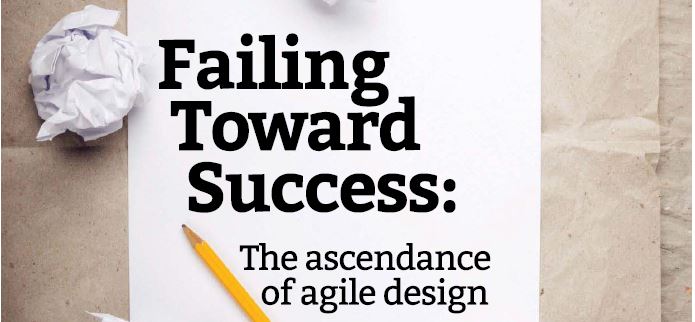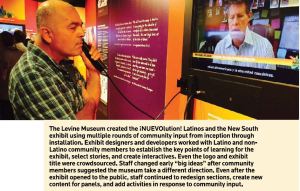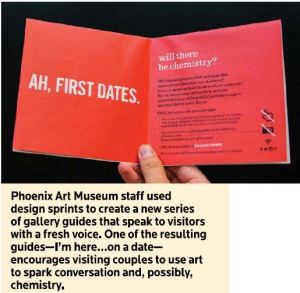
This excerpt from TrendsWatch 2017 originally appeared in the March/April 2017 issue of Museum magazine.
“If you’re creating things, you’re doing things that have a high potential for failure, especially if you’re doing things that haven’t been done before. And you learn from those things …failure is another word for experience.”
Both for-profit and nonprofit organizations increasingly recognize that failure is a necessary part of a successful design process. It isn’t easy to adopt this approach when “failing” is conflated with “being a failure,” but we are coming to realize that blanket negative characterizations of failure damage us as learners, workers, organizations, and as a culture. In a time of rapid social, technological, and economic change, organizations have to try new things in order to succeed, and such innovation requires a tolerance for risk. Given that museums’ business models
are experiencing profound disruptions, this field in particular needs to be comfortable with positive failure, but museums need encouragement, tools, and positive feedback if they are to buck the long tradition of perfectionism that has characterized the sector.
Given all the hoopla in the past decade as evidenced by the proliferation of catchphrases like “fail fast,” “fail forward,” “fail smart” -the concept of failure is in danger of being labeled a fad. Searching “failure” on Amazon identifies more than 24,000 books on the subject, and Astro Teller’s recent TED Talk on the “Unexpected Benefit of Celebrating Failure” has already racked up more than 2 million views. But underlying the hype is a profound shift away from traditional business practices and toward lean, nimble, adaptive organizations. In times of change and uncertainty, rapid prototyping and iterative design-trying small, fast experiments, testing their success and adjusting accordingly-entail less risk in the long run than investing huge amounts of resources implementing one, theoretically perfect plan. Learning productive methods of failure has become an important strategy for businesses of all sizes, from big established companies that don’t want to become dinosaurs to small startups hungering for success.
Creating a climate of productive failure requires a workplace culture that values individual experimentation and input, but the characteristics of innovative organizational culture are often at odds with traditional, command-and-control management structures. Organizations, particularly those with entrenched hierarchical structures, are finding they need to adopt frameworks that support experimentation and risk-taking. Recent decades have seen the proliferation of a wide variety of systems, methodologies, and approaches that support taking small, productive risks and learning from small, rapid failures. Peter Sims documents how large established organizations like Amazon, Pixar, Google, Hewlett Packard, and the US Army succeed via making “little bets” -low-risk actions to discover, develop, and test an idea in support of ambitious long-term goals. At the other end of the spectrum, the Lean Startup Movement is designed to help new businesses find their market niche via continual testing. The principles of Serum-an iterative, incremental approach to software development designed to deal with the unpredictable, shifting needs of the end user-spread within organizations as other departments emulate the successful practices of their IT staff. And the Serum approach has diffused to other fields as people with technology backgrounds become core staff and leaders in a variety of sectors.
What This Means for Society
To prepare learners for the 21st-century workplace, education is shifting to privilege critical thinking research skills, creativity, perseverance, adaptability, and teamwork over rote memorization of facts. This transition will require a cultural shift in education toward fostering exploration, curiosity, and experimentation, all of which inevitably involve “failing” as a productive part of learning new things. In the future, a good student’s report card may be sprinkled with Fs that laud little failures.
Even as society struggles over the downside of excess screen time for kids and assesses the potential for video games to foster violent or antisocial behavior; we increasingly recognize that games, particularly digital games, are a means of giving continuous feedback, helping kids see failure as an inevitable and unremarkable part of “leveling up”. And we are realizing that the characteristics of productive failure in games could be grafted onto other areas of endeavor: giving continuous feedback; making failure private; normalizing failure as an expected part of a process; and immediately presenting a “player” with the chance to try again.
A bias against failure in the publication of research findings is holding back progress in a variety of fields. Not sharing the results of thousands of experiments that “fail” -i.e., generate negative results-obscures important findings, creates bias in metadata studies, and wastes the time of researchers who replicate experiments they didn’t know had already taken place. That may mean, for example, repeating medical trials that subject volunteers to treatments that are already known (by someone) to be ineffective. Individual journals and professional societies are trying to crack down on publication bias, but there is no simple fix. One study conducted in 1987 found that suppression of negative results isn’t primarily due to editorial decisions: it’s a result of self-censorship by researchers who didn’t even write up and submit papers describing their work. In other words, bias against failure is itself a failing of academic culture.
Valuing failure can amplify or counteract concurrent social trends. User-centered design creates a meaningful role for the public at a time when participation is increasingly valued as part of a cultural experience. And learning to accept failure as part of a mutual process of learning what works and what doesn’t work in our complex society can help to counteract increasing cultural and political polarization. 
What This Means for Museums
Museums, as a sector, share a culture of perfection that places large bets on getting a product-whether an exhibit, program, or building right the first time. This culture is often rooted in traditional, hierarchical management structures that evolved in a time that valued authority and control over collaboration and creativity. Museums that decide to move away from dysfunctional perfectionism have to work consciously to change an organizational culture that discourages risk-taking. A culture of continuous improvement can’t simply be isolated in a new department or grafted onto traditional structures-it requires fundamental shifts in a museum’s ethos. including new forms of leadership and management.
Museums are at risk of lagging dangerously far behind the rapid changes shaping audience, culture, and technology. The traditional timeframe for major projects is too long for truly responsive design. If exhibits and publications take five to ten years to produce, and if institutions take another one to three years to collect evaluation data, operations will only improve on decadal cycles. “Failure-based” design processes incorporate early input from the end-user. For example, one methodology being widely adopted in the cultural sector is design thinking: a set of principles that include empathy with end-users, rapid prototyping, and a tolerance for failure. This is a welcome counterbalance in organizations such as museums, orchestras, or opera companies that have a long history of producing performances, exhibits, and programs that seem perfect to the staff or funders, but may not resonate with audiences. Recruiting the public to test prototypes is not just a way to improve the final design-it is itself a valuable form of engagement that can humanize the museum and make the audience feel invested in the outcome.
Museum funders are beginning to recognize the strength of “small bets” as a path toward innovation. In 2011, the Institute of Museum and Library Services (IMLS) started offering Sparks! Ignition Grants to support one-year, rapid prototyping projects with grants of $5,000 to $25,000. This program has now been rolled into IMLS’s National Leadership Grants for Museums, and the maximum award increased to $50,000.
Museums Might Want to…

Try small, controlled experiments to introduce innovative design within the existing culture. Learn from projects like the San Francisco Opera (SFO)’s Barely Opera, in which two students from Stanford University’s Hasso Plattner Institute of Design introduced the SFO to new ways of thinking. That experiment, which started with staff bouncing ideas off random strangers at the Ferry Building, resulted in a wildly popular event at a bar that encouraged audience members to don costumes, spin a game-style wheel to select songs. and listen to members of the opera company deliver laid-back, humorous interpretations of classic works. Barely Opera pushed SFO staff to work outside their comfort levels and celebrate failures in the process and resulted in the creation of a new production department called “SF Opera Lab” dedicated to producing low-cost, low-risk events pitched at specific new audiences.
Adopt design thinking or another established model as the museum’s usual methodology for developing new exhibits, programs, and services. There are many excellent programs and resources, including IDEO’s ExperienceInnovation: A Workshop for Teams; the Harvard Extension School’s Design Thinking Workshop; and Stanford University’s d.school’s Virtual Crash Course in Design Thinking. It is also increasingly common to find sessions and workshops on design thinking and related topics at museum conferences or in online training designed for museum professionals.
Review their own organizational cultures and find ways to encourage productive risk-taking. This approach may include budgeting “mad money” to encourage small risks in the interest of R&D or creating an experimental “lab” dedicated to taking supported risks. Or museums could build recognition and reward for risk-taking into systems
for performance review and compensation. However, the mixed record of such experiments demonstrates that successful innovation projects need to be supported at the leadership level and embedded in the organizational culture, rather than depending on charismatic, talented individuals or small groups. Help reshape cultural attitudes toward failure by incorporating positive narratives into their exhibits and programs. Museums can help society see failure as a normal and valued part of the learning process. Join the growing number of museums willing to share their failures, as well as what they learned from these “unsuccessful” experiments, in public forums, in print, on blogs, or in conference sessions. Museum professionals can reward their colleagues’ candor with praise and appreciation. Museum associations can examine their own practices for accepting papers and sessions, and address any institutionalized bias against failure that may be suppressing useful information.
Museum Examples
In the past decade or so, a number of museums have created “labs” that carve out a place for staff to mess around: Cooper-Hewitt Labs, the Metropolitan Museum of Art’s MediaLab, IMA Labs at the Indianapolis Museum of Art, Louvre-DNP Museum Lab, and the Carnegie Museums’ Innovation Studio, to name a few. As Philbrook Museum of Art Director Scott Stulen (formerly of the Indianapolis Museum of Art) said, “Failure is such a big part of creativity. Most R&D labs are built on that. But it’s not just failing-it’s having learning as a creative outcome.” However, the mixed track record of these startups demonstrates how hard it can be for the culture of innovation to take hold.
At the Minneapolis Institute of Art (Mia), a “failure-friendly” approach that began as an effort to deliver improved digital content wound up redefining project management for the entire organization. Staff moved away from detailed project plans, strict timelines, and fixed deliverables in favor of rapid iteration and direct public engagement throughout the design process. They found that by educating senior executives in the practice of agility-particularly the concept of self-organized teams-decisions could be made without waiting for traditional, hierarchical approval chains. And teams found they could enhance trust in this process by demonstrating how results of public testing lead directly to improvements. For example, using this agile approach, a dedicated team of Mia staff published more than 100 ArtStories and created a website that uses direct feedback to make continuous improvements in short iterative cycles.
Some museums are using “design sprints” to drive rapid development of content, experiences, services, or digital tools. The Phoenix Art Museum sent a team of education staff off-site for a blitz session to create a set of ”I’m Here” visitor guides. Starting with a brain dump on everything they knew about visitor motivations, by the end of the day they had content their designer could use to create the working prototypes. Staff from the Digital Product Group at the British Museum ran a design sprint focused on improving wayfinding. Working in two half-days, and incorporating visitor interviews, they used the process to educate their colleagues about the strength of user-centered design and to break down silos within museum departments.
Starting in 2012, with a break in 2015. a rotating cast of museum professionals led by Sean Kelley of the Eastern State Penitentiary has populated a session titled Mistakes Were Made at the AAM Annual Meeting & MuseumExpo. By sharing funny, honest accounts of things that went radically wrong, the panelists help destigmatize failure as well as ensure that some broader benefit comes from their unfortunate experiences. This session culminates in the audience awarding the “AAM Epic Failure Trophy” to the best mistake, celebrating “sharing as the first step in learning”. This national session is so popular that it has spawned local versions as well.
Further Reading
At Museums and the Web 2016, Douglas Hegley, Meaghan Tangen, and Andrew David presented “The Agile Museum” (mw2016.museumsandtheweb.com/paper/the-agile-museum/)-a paper describing how the Minneapolis Institute of Art is creating an agile work environment. This case study emphasizes the need to change leadership and management practices in order to support a culture of rapid iteration and experimentation.
The website Design Thinking for Museums, (designthinkingformuseums.net) edited by Dana Mitroff Silvers, shares case studies, blog posts, and resources. It grew out of a 2012 partnership between the San Francisco Museum of Modem Art and Stanford University’s Plattner Institute of Design, and offers a compendium of links to free online toolkits.
Trends Watch 2017 is made possible with the generous support of Blackbaud, Huntington T. Block Insurance Agency, PGAV Destinations, and Solid Light.








